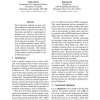Free Online Productivity Tools
i2Speak
i2Symbol
i2OCR
iTex2Img
iWeb2Print
iWeb2Shot
i2Type
iPdf2Split
iPdf2Merge
i2Bopomofo
i2Arabic
i2Style
i2Image
i2PDF
iLatex2Rtf
Sci2ools
ACL
2006
2006
Soft Syntactic Constraints for Word Alignment through Discriminative Training
Word alignment methods can gain valuable guidance by ensuring that their alignments maintain cohesion with respect to the phrases specified by a monolingual dependency tree. However, this hard constraint can also rule out correct alignments, and its utility decreases as alignment models become more complex. We use a publicly available structured output SVM to create a max-margin syntactic aligner with a soft cohesion constraint. The resulting aligner is the first, to our knowledge, to use a discriminative learning method to train an ITG bitext parser.
ACL 2006 | ACL 2007 | Alignments Maintain Cohesion | Soft Cohesion Constraint | Word Alignment Methods |
| Added | 30 Oct 2010 |
| Updated | 30 Oct 2010 |
| Type | Conference |
| Year | 2006 |
| Where | ACL |
| Authors | Colin Cherry, Dekang Lin |
Comments (0)

